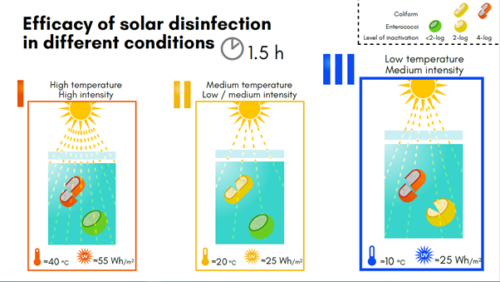Our new study, Solar disinfection – An appropriate water treatment method to inactivate faecal bacteria in cold climates 1, was recently published in Science of the Total Environment. In short, the conclusion of the study is that solar water disinfection works well also in a cold climate.
Background
Solar disinfection (SODIS) is an inexpensive drinking water treatment method. It is applied in tropical and sub-tropical low-income countries in everyday use, as well as in disaster settings when resources are scarce. Solar radiation destroys most of the potentially disease-causing microbes in the treated water and it thus becomes drinkable. SODIS is applied simply by filling transparent containers with treatable water, leaving them in the sunlight and drinking the water after some hours. Although this method is not perfect (it does not disinfect very resistant pathogens2), it has been found to effectively reduce diarrheal incidents in field studies1.
We decided to study SODIS performance in cold climate, because it has been unclear whether SODIS could be utilized also in cool areas such as the Himalaya region, southern South America or currently crisis-facing Ukraine. It has been thought that solar radiation levels, and ideally also the temperature, need to be high for solar disinfection to be effective3.
Methods
To investigate the applicability of SODIS in the cold, we performed SODIS experiments in the humid continental (temperate) climate of southern Finland in March and April. In practice, we filled so-called Minigrip / Zip lock bags (made from polyethylene i.e. PE) with contaminated water and recorded what kind of radiation doses and times are required for any degree of bacteria to be disinfected in different weather conditions.
Results & Discussion
We found that even in the low radiation & low temperature conditions of early Finnish Spring, solar disinfection was working very well. In fact, it was working even better than in the typical hot & intense radiation conditions solar disinfection is usually applied in (Figure 1). More specifically, the radiation dose needed for disinfection of 99.99% of two types of faecal bacteria was surprisingly the lowest in the coldest conditions (~10 °C) tested in our experiments. The disinfection process was however the fastest in the typical solar disinfection conditions, although it was almost equally fast also in the coldest conditions tested.
Disinfection of 99.99% of bacteria was reached within 6 h (the advised time to apply SODIS optimal conditions) in all experiments conducted in Finland, which further indicates SODIS works well in a cool climate. The success of SODIS in these conditions could be due to slower metabolism and thus slower UV repair mechanisms in bacteria in lower temperatures that are optimal for them.

If you want to purify water with solar disinfection, this is what you do:
- Fill a clean transparent container such as soda bottle (PET plastic) or preferably a sealable zip lock bag (PE plastic) with water you want to treat, such as fairly clear lake water.
- Leave the containers in direct sunlight for six hours (if the weather is sunny) or for two days (if the weather is cloudy). Note that this method does not work in rainy weather.
- Your water is ready! Drink the water preferably within 24 h.
Author

Anni Juvakoski, DSc researcher with the Water and Development & Water and Wastewater Engineering Research Groups, Aalto University
1 Juvakoski, A., Singhal, G., Manzano, M. A., Moriñigo, M. Á., Vahala, R., & Levchuk, I. (2022). Solar disinfection–An appropriate water treatment method to inactivate faecal bacteria in cold climates. Science of The Total Environment, 154086.
2 McGuigan, K. G., Conroy, R. M., Mosler, H. J., du Preez, M., Ubomba-Jaswa, E., & Fernandez-Ibanez, P. (2012). Solar water disinfection (SODIS): a review from bench-top to roof-top. Journal of hazardous materials, 235, 29-46.
3 Moreno-SanSegundo, J., Giannakis, S., Samoili, S., Farinelli, G., McGuigan, K. G., Pulgarín, C., & Marugán, J. (2021). SODIS potential: A novel parameter to assess the suitability of solar water disinfection worldwide. Chemical Engineering Journal, 419, 129889.

